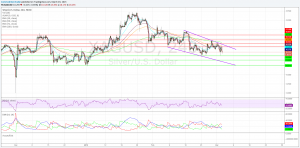With the US dollar at highs not seen since the mid-2000s, precious metals remain weak.
 Bullion.Directory precious metals analysis 3 March, 2015
Bullion.Directory precious metals analysis 3 March, 2015
By Christopher Lemieux
Senior Analyst at Bullion.Directory; Senior FX and Commodities Analyst at FX Analytics
Silver is, at times, violently volatile and noticeably a proxy for the US dollar. With the dollar at levels not seen since 2005 and 2006, sentiment for precious metals remains weak. There are two factors for this, and it doesn’t matter which one chooses.
The dollar has been able to hold current levels thanks to the perception that the Federal Reserve will – at some point – incrementally increase the Fed funds rate.
Many believe this will happen because the US central bank has not boosted rates since 2006, and it’s coming time to do so.
Others actually feel the US economy is “strong” enough to handle a increase in rates; although one only has to look to mortgage applications to see how sensitive to rates Americans really are.
The other faction foresees deflation, if not just a prolonged level of disinflation – and with over 20 central banks cutting rates this year alone, the currency war has been nasty.
With each major central bank racing to devalue their respective currencies to zero value, the dollar is the de facto “winner.”
When currencies that the dollar is pegged to within the dollar index drop, the dollar increases and further intensifies disinflationary pressures.
That alone is negative for precious metals. What is not negative for precious metals is the likely reaction from the Fed to quell dollar strength and “boost” economic growth, more QE.
Silver is currently trading within a descending wedge, a technical pattern that consists of two trend lines that follow the trend but with price action ranges that begin to narrow. What is striking is that wedges are reversal patterns. This does not mean silver is poised to jump to the upside immediately, but it is a pattern to watch out for. Essentially, price action will continue to narrow on weakening volume to a point of support.
Then, prices rally.
In regards to silver’s wedge, traders are likely to push silver lower to support within the wedge as long as the dollar’s strength remains. The wedge’s descending trend began ounce silver failed to move significantly passed $18.50 per toz. Key support levels are seen at $16.05, $15.80 and $15.50 per toz.
With using the wedge to a trader’s advantage, the rally from support that breaks the descending resistance is typically a “false” move. A pullback from the breakout will likely occur to key support, likely to retest the former descending resistance now support.
If it is a true breakout, prices will climb higher from the pullback to support.












 Material provided on the Bullion.Directory website is strictly for informational purposes only. The content is developed from sources believed to be providing accurate information. No information on this website is intended as investment, tax or legal advice and must not be relied upon as such. Please consult legal or tax professionals for specific information regarding your individual situation. Precious metals carry risk and investors requiring advice should always consult a properly qualified advisor. Bullion.Directory, it's staff or affiliates do not accept any liability for loss, damages, or loss of profit resulting from readers investment decisions.
Material provided on the Bullion.Directory website is strictly for informational purposes only. The content is developed from sources believed to be providing accurate information. No information on this website is intended as investment, tax or legal advice and must not be relied upon as such. Please consult legal or tax professionals for specific information regarding your individual situation. Precious metals carry risk and investors requiring advice should always consult a properly qualified advisor. Bullion.Directory, it's staff or affiliates do not accept any liability for loss, damages, or loss of profit resulting from readers investment decisions.

Leave a Reply